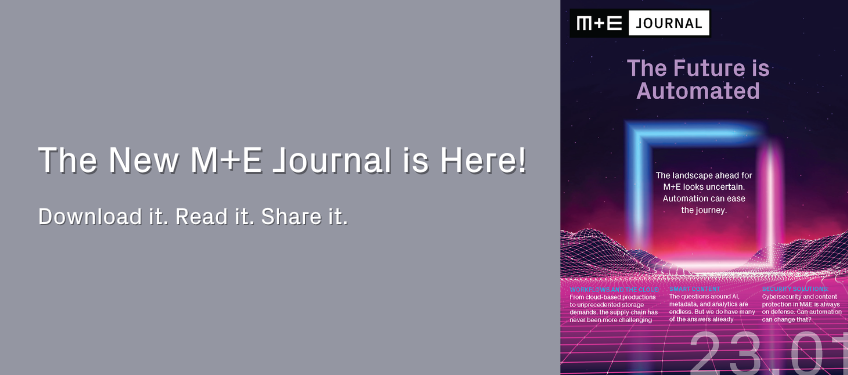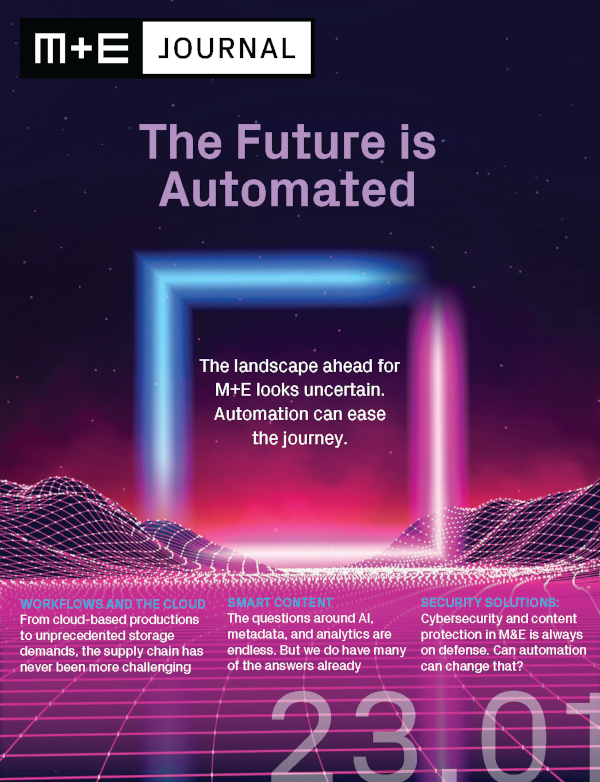M+E Daily

MESA’s Spring M+E Journal Goes Live
Story Highlights
The spring edition of the “M&E Journal,” published by MESA and geared toward senior media and entertainment executives who oversee their companies’ digital futures, is now available online.
The 152-page publication features insights from more than two dozen MESA members, from Alteon to Wasabi Technologies, with the issue’s main focus centred on how automation is impacting every corner of the media and entertainment business.
Along with the cover section — “The Future is Automated” — the issue offers industry insights for several crucial industry areas, including “Workflows and the Cloud,” “Smart Content,” and “Security Solutions.”
Additionally, the “M&E Journal” also features columns from MESA’s executive leadership.
Here’s a quick look at what’s included in the “The Future is Automated” section:
• “Creating a More Connected Future for Creators” by Alteon’s Matt Cimaglia. Automation is encroaching on every aspect of our jobs. It means cost savings, fewer headaches, and more efficiency. It means a more equal playing field for a global pool of undiscovered talent. The media industry is democratising every day, and automation is a key part of that story.
• “The Value in Automating the Future” by LADB’s Eric Collins and Mark Wright. Immediate benefits of automation in digital content processing include faster completion, tackling a higher volume of work, fewer errors, and the ability to rely on a consistent process. Automation means the elimination of repetitive manual work, allowing for resources to be reallocated, and with decreased human intervention, security and confidentiality is significantly increased.
• “Automate For Your Bottom Line” by FilmTrack’s Michael McGuire. Synchronising different tech stacks is clunky, creates risks and costs, and prevents you from staying ahead in the connected world. Integrating and automating your contracts, avails, and financials in a single platform limits risk and makes you more money.
• “How Smart Automation Can Turbocharge Your Media Supply Chain” by Fabric’s Andrew Holland. As streaming services face a period of consolidation, the ever-present search for value and efficiency in the media supply-chain has increased in intensity – and thankfully due to automation there are plenty of efficiencies to be found.
• “Why Testing Merits a Starring Role in M+E Automation” by Cognizant’s Jeff Davidson. Testing isn’t what you think of first when you think automation in media and entertainment. Yet with the media supply chain under duress as companies struggle with heavier workloads amid intense cost cutting, testing at scale opens the door to streamlined global delivery. Simply, it has the ability to help companies get content out the door faster.
 • “Automation is Nothing New. So Why Isn’t Everyone Using It?” by Blu Digital Group’s George Rausch. While automation can bring efficiency gains to tasks and workflows such as digital asset management and postproduction, the industry’s multi-faceted nature and the need for high-quality outputs make it challenging to implement.
• “Automation is Nothing New. So Why Isn’t Everyone Using It?” by Blu Digital Group’s George Rausch. While automation can bring efficiency gains to tasks and workflows such as digital asset management and postproduction, the industry’s multi-faceted nature and the need for high-quality outputs make it challenging to implement.
However, designing well thought-out automation workflows and using task-specific tools can enhance efficiency and productivity.
• “Version Control: The Foundation for Automation in Virtual Production” by Perforce’s Jase Lindgren and Ryan L’Italien. This article explores the theme of automation through the lens of version control systems (VCS). As the single source of truth for all digital assets, VCS provides a foundation for continuous integration and delivery systems, enabling the automation of content creation, submission, building, and rendering. This piece emphasises the critical role that VCS plays in streamlining workflows and facilitating innovation in the digital landscape.
• “Balancing Machine Efficiency with the Human Touch in Quality Control” by 3rd i Digital’s Ramón Bretón. Automation greatly benefits quality control and the preparation of files for final delivery.
However, the advantages of bringing to bear the gifted eyes and ears of seasoned quality control professionals on M&E content cannot be undervalued. Balancing machine efficiency with the human touch is key when designing workflows and preparing services for clients.
• “A Voice for Automation” by AppTek GmbH’s Volker Steinbiss. Dubbing is the most labor and cost intensive type of media localisation, aiming to reproduce the original experience for the target language audience.
Automatic video dubbing aims to automatically re-voice videos to make them more easily accessible to audiences in other languages at just a fraction of the time and cost.
• “Automation and Content Production: Cracking ‘The First Mile’” by Tech Mahindra’s Kishlay Baranwal. Many leading media organisations have taken steps to transform (at least part of) their content distribution ecosystem — tackling upstream workflows, however, has proven to be more challenging. This article will outline a strategic approach for media and entertainment organisations to crack what I call the “First Mile” problem — giving your content production workflows the wheels they deserve to achieve comprehensive transformation across the value chain.
• “Don’t Neglect Glossaries When Automating Localization” by Iyuno’s Bartosz Adamczewski and Allan Dembry. Glossaries are essential in localisation, but often neglected in automation. Automating glossary creation and management offers efficiency and consistency benefits, reduces linguistic ambiguity, enables information extraction, and enhances quality and accuracy of automated translations in fields with specialised terminology.
• “Automation in Post-Production: Maximizing Efficiency and Creativity” by IDC-LA’s Ryan Gladden. In today’s post-production environment, automation is becoming more critical to the success of a project. Automation is no longer a concept, but a reality that can help streamline the entire post-production workflow.
It can help teams save time, money, and resources, while freeing up staff to focus on the creative aspects of our art.
• “Become Agile with Intelligent Test Automation” by Softtek’s Jorge Zarur. As companies advance on creating new revenue streams to reach a promise of delivering more functionality to end users through Agile DevOps, QA’s Agile Testing is becoming ever so relevant. QA being the last step in the development process, having fast, reliable tests is now indispensable.
• “Bringing Platform Power to Automation” by Signiant’s Rick Capstraw. The benefits of automation are undeniable, but it is expensive and inefficient for each media company to undertake a custom design/build workflow initiative. With a multi-tenant SaaS platform that is already operating at scale, Signiant is uniquely positioned to deliver ecosystem leverage via reusable, productised workflow building blocks.
Beginning Monday, June 26, look for stories from the spring edition of the “M+E Journal” every week in the “M+E Daily” newsletter.









